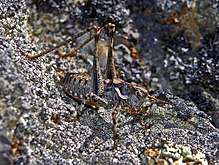Antaxius pedestris
Antaxius pedestris is a species of "katydids crickets" belonging to the family Tettigoniidae. It was originally described by Johan Christian Fabricius under the scientific name of Locusta pedestris.[2]
| Antaxius pedestris | |
|---|---|
 | |
| Antaxius pedestris pedestris, male | |
.jpg) | |
| Antaxius pedestris pedestris, female | |
| Scientific classification | |
| Kingdom: | |
| Phylum: | |
| Class: | |
| Order: | |
| Family: | |
| Genus: | |
| Species: | A. pedestris |
| Binomial name | |
| Antaxius pedestris (Fabricius, 1787) | |
| Synonyms | |
| |
Subspecies
Subspecies include:[3]
- Antaxius pedestris apuanus Nadig, 1958 - occurs in Italy, Austria and Switzerland
- Antaxius pedestris pedestris (Fabricius, 1787) - occurs in France, Italy, Austria and Switzerland
Distribution
This species is present in Pyrenees of Spain and in the western and southern Alps of Austria, France, Italy and Switzerland.[4]
Habitat
It prefers warm habitats in mountainous and semi-mountainous areas with high vegetation and low bushes, at an elevation up to 2,000 metres (6,600 ft) above sea level.[5][6]
Description
Antaxius pedestris can reach a length of about 15–23 millimetres (0.59–0.91 in).[6] Its ovipositor is slightly shorter than the body, it reaches about 13–18 millimetres (0.51–0.71 in).
The basic color of the body is dark brown, gray brown or dark gray with light whitish or yellow to light gray drawings. Pronotum is tinged with white on the lateral margins. Abdomen is long, thick and strong. Wings are very short in the females, while in males they protrude 3–4 mm out from under the pronotum.
Cerci of the males are unusual. They are whitish, flattened and internally toothed. All pairs of the powerful legs bear small spines on the lower part.[6]
Biology
Adults can be found from July to October.[5] They feed on plants and insects, mainly small locusts. Eggs are laid in the ground.[5]
References
| Wikispecies has information related to Antaxius pedestris |
| Wikimedia Commons has media related to Antaxius pedestris. |
- Hochkirch, A., Monnerat, C., Braud, Y., Fontana, P., Zuna-Kratky, T., Roesti, C. & Rutschmann, F. (2018). "Antaxius pedestris". IUCN Red List of Threatened Species. 2018: e.T47709836A107935998. Retrieved 8 April 2019.CS1 maint: multiple names: authors list (link) CS1 maint: ref=harv (link)
- Catalogue of Life
- BioLib.cz
- Fauna Europaea
- Pyrgus - Orthoptera and their ecology
- Linnea
- Fabricius (1787), Mantissa insectorum exhibens species nuper in Etruria collectas a Ptro Rossio, Pisis, Polloni
